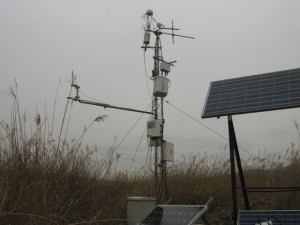- Coordinates: 37°0‘42.26” N, 3°36’20.65’’ W
- Height:()m
- Base level:()
- Country: Spain
- InGOS observations: ()
- Responsible partner: UGR
- Responsible PI: Penelope Serrano-Ortiz
- TNA access request page for Padul
- Website: ()
General
The experimental site is a wetland of about 0.7-0.8 km2 near El Padul, a village in the province Granada, southern Spain, and located within the Sierra Nevada National Park.This wetland lies in the Padul valley at an elevation of 744m and has recently been included in the Ramsar Convention for Wetlands. The vegetation cover is dominated by Phragmites sp. There is a lake resulting from discontinued peat extraction activities that now provides a valuable bird habitat. Below the surface and drainage channel network, the wetland contains peat layers of close to 100 m thickness in the North-East.The wetland area hasbeen altered over the past decades including drainage for small-scale agriculture, peat extraction, and eutrophication from surrounding human activities. A highly variable water table during the annual cycle is a result of strong seasonal discharge from spring snow melt in the mountains, human intervention (changes in hydrology), and the semi-arid warm climate including an extensive dry period in summer. The eddy covariance tower (CSAT-3 anemometer and LI-7500 and LI-7700 IRGAs) was installed the beginning of 2013 for measuring ecosystem CO2, H2O, CH4 and energy fluxes (37°0’42.26″N, 3°36’20.65″W), together with meteorological and soil state instruments for measuring net radiation, photosynthetic photon flux density, air temperature and humidity, soil temperature, soil heat flux and water table level.
Access
Access will be granted as soon as UGR has been accepted by the European Commission as a new partner of InGOS. Proposals can already be submitted via the application form, so that in case of approval measurements can start as soon as possible.




